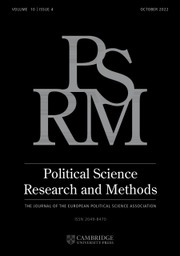Article contents
Challenges to Inference in the Study of Crisis Bargaining*
Published online by Cambridge University Press: 16 March 2015
Abstract
The possibility that actors strategically condition their behavior onpartially unobservable factors poses a grave challenge to causal inference,particularly if only some of the actors whose behavior we analyze are atrisk of experiencing the outcome of interest. We present a crisis bargainingmodel that indicates that targets can generally prevent war by arming. Wethen create a simulated data set where the model is assumed to perfectlydescribe interactions for those states engaged in crisis bargaining, whichwe assume most pairs of states are not. We further assumeresearchers cannot observe which states are engaged in crisis bargaining,although observable variables might serve as proxies. We demonstrate that anaïve design would falsely (and unsurprisingly) indicate a positiverelationship between arming and war. More importantly, we then evaluate theperformance of matching, instrumental variables, and statistical backwardsinduction. The latter two show some promise, but matching fares poorly.
Information
- Type
- Original Articles
- Information
- Copyright
- © The European Political Science Association 2015
Footnotes
Philip Arena, Visiting Assistant Professor of Political Science,Department of Political Science, University of Rochester, HarknessHall, Rochester, NY 14627 (filarena99@gmail.com). Kyle A. Joyce, Assistant Professorof Political Science, Department of Political Science, University ofCalifornia, Davis One Shields Ave., 469 Kerr Hall, Davis, CA 95616 (kjoyce@ucdavis.edu). Theauthors thank Amber Boydstun, Daina Chiba, Sean Gailmard, HeatherMcKibben, Randy Siverson, Zeev Maoz, Jamie Monogan III, Bill Reed,Toby Rider, Jas Sekhon, and Curt Signorino for valuable comments. Theauthors also thank Matt Buttice for research assistance. This articlealso benefited from comments provided by the participants at EITM(2010) and attendees of the Annual Meeting of the Society forPolitical Methodology (2010). To view supplementary material for thisarticle, please visit http://dx.doi.org/10.1017/psrm.2014.42
References
- 5
- Cited by

